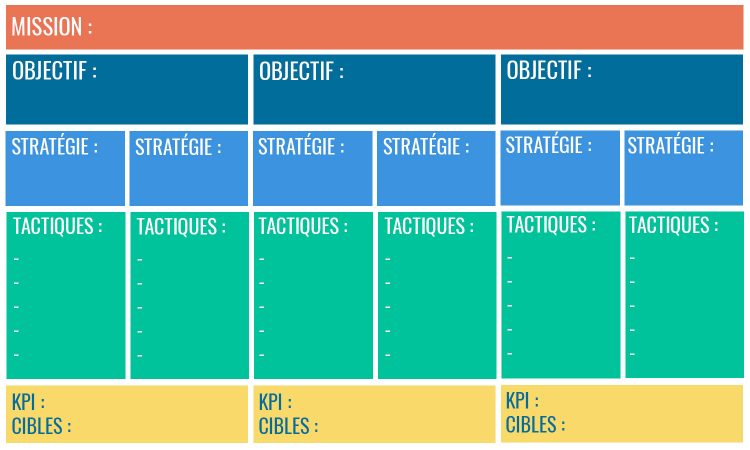Objectives, strategies, tactics: what are they exactly?
Article updated on December 18, 2018.
Before launching marketing campaigns, redesigns or any online or offline project, it is advisable for a company to define its strategic plan, the ideal being to use it as a guide to direct any action of the company, whatever whether.
It is often the lack of a clear strategic plan that causes the failure of a marketing campaign.
Ok, but what exactly is a marketing plan? Basically, it is to identify the objectives to be achieved and how to achieve them, as well as the strategies and tactics that will be put in place to achieve them .
I realized during certain mandates that these terms can be confused. Moreover, if they are not concrete enough, they will be difficult to interpret and use by the company's teams. As Graham Kenny 's article explains very well , a strategic plan is sometimes confused with a list of objectives when the latter should be a reflection on what makes the success of the company or organization and how to optimize it.
Before going into the detail of each element, here is a diagram to better understand the hierarchy of a strategic plan:

GET THE EXCEL VERSION OF THIS STRATEGY CANVAS
Leave us your email address, we will send it to you within minutes.
Let's start from the most general to the most specific.
1. MISSION: THE “WHY”
The mission of the company, of a content or a campaign, is a broad vision of the essential question: Why does the company exist? What is his ideal? What is she trying to accomplish? The mission of a website can be completed by its orientations: to inform, educate, sell, connect, etc.
Google 's mission is to organize the world's information with the goal of making it accessible and useful to everyone. And that of Facebook is to give people the power to share and make a more open and connected world.
To illustrate each term, I'll use the example of a humanitarian organization with a mission to fight world hunger (nice mission, isn't it!).
Understanding and integrating the company's mission helps guide long-term goals, strategies and tactics.
2. OBJECTIVES: THE “WHERE TO”
The objectives determine the goal to be achieved: increase its market share, improve its profitability, increase brand awareness in a given region… and they must be measurable over time.
In the example of our humanitarian organization: Increase donations by 20% over one year, Increase community engagement on social presence by 10%.
TIPS AND TRICKS :
-
Be concrete: If the objective of an army was to win, it would certainly be preferable, but it would not help to know which direction to take to get there! Similarly, having a goal of having a good year 2015 for a decoration shop remains too vague since the definition of a good year could be completely different for another for a shop.
-
Define a reference period: The objective can be annual, monthly or quarterly, but it must be integrated into a period of time. This will help in particular to check whether it has been reached or not.
-
Be measurable: For example, for the objective “increase my market share,” it is preferable to add an order of magnitude (for example 10% or 20%) to be able to check whether the objective is achieved as well as the strategies and effectiveness during the reference period.
-
Be realistic: In life, it is well seen to be ambitious, but let's keep our feet on the ground! To remain realistic, I advise you to analyze your previous results and look for figures from your industry in order to assess your potential for evolution in the market.
-
To summarize and in mnemonic way, these good practices are called SMART goals in English: S pecific, M easurable, A ctionable (or A ssignable), R ealistic and T imely.
3. STRATEGIES: THE “HOW”
For each objective then comes the stage of strategies: what approach(es) do we choose to achieve the objective?
Always with the example of our humanitarian organization, our strategies could be to create partnerships with celebrities to support the actions of the organization or to invest in the optimization of the website for the collection of online donations.
TIPS AND TRICKS :
- Think of the 3 dimensions of marketing : The media that the organization has such as the website ( owned ), what the company has obtained as a result of its actions such as shares on social media ( earned ), paid media such as advertising traditional and paid referencing .
-
Stay consistent : Regardless of the available budget, staying consistent across strategies will achieve the goal. For example, if the company does paid search campaigns but does not optimize its site for organic search, this can send an inconsistent message to users.
-
Think about the conversion funnel: Actions can be taken at the top of the funnel (awareness, new markets…), in the middle of the funnel (generating leads), or at the end of the funnel (improving the conversion rate ).
-
Analyze: Study the successes of previous years, look at good practices in your market or different markets but can be adapted to your market.
-
Prioritize: Based on objectives, budget, specific events of the year and those of the previous year, or even elements where the company is performing less well (e.g.: improving retention if we already have a base visitor/audience, but little engagement or conversion). In short, identify what absolutely must be done this year and what could be interesting, but not urgent.
4. TACTICS: THE “WHAT”
Tactics represent the tool, the action, the operational strategy: what are we going to do concretely tomorrow to achieve the objective at the end of the year?
For example: creating videos on the situation of hunger in the world in storytelling mode , carrying out A/B tests for the fundraising page on the website, sharing photos with engaging texts, etc.
TIPS AND TRICKS :
-
Consider available resources : budget, staff, technical equipment, etc.
5. PERFORMANCE INDICATORS AND TARGETS: THE “HOW MUCH”
To measure the progress of the company in achieving its objectives, we talk about performance indicators (KPI: Key Performance Indicators). These are the metrics to observe and which will allow us to say whether or not the strategic plan has been effective.
Examples: conversion rate, task completion rate (filling out a form), engagement rate.
We call target the number that we want to reach for the objective. Here, I've included the target directly in the goal: 20% for increased donations, 10% for improved engagement.
TIPS AND TRICKS
-
Think efficiency and quality: I quote here Avinash Kaushik: “ Choose spectacular indicators! Indeed, increasing the number of visitors to your website is good, but if these visitors do not correspond to your audience, it will be counterproductive! An indicator such as the conversion rate will certainly be more valuable than the number of visits to your site.
-
Segment: Some markets are not at the same level of maturity. Thus, the target of a performance indicator may be different depending on the segment.
Here are a couple of case studies, including the strategies developed for each client:
Fundraising strategy: https://www.adviso.ca/clients/fondation-jean-lapointe/
Page optimization: https://www.adviso.ca/clients/protegez/
So, was all this more or less what you’d had in mind when you used these terms before?








